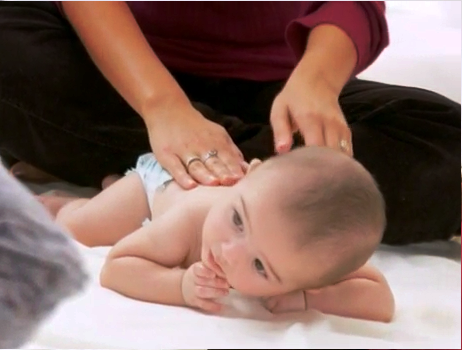
I am careful to say “infant” or “newborn” reflexes (also called primitive reflexes) because it is important to note that these reflexes are meant to disappear as your baby grows older and if they don’t disappear or integrate, the reflex could interfere with development and purposeful movement.
A reflex is an involuntary muscle reaction triggered either spontaneously or by a very specific type of stimulation. Some reflexes remain throughout adulthood, but infant reflexes develop in utero, should be fully present at birth, will go away over the first year or two and are intended to aid in the survival of the newborn baby. For example the rooting, sucking, and swallowing reflexes help the baby get nourishment. These reflexes then diminish and go away completely over the course of the first year to 18 months.
- Sucking Reflex
When gentle pressure is applied to the roof of the baby’s mouth or tongue she will close her lips and begin to suck. This reflex starts to diminish around three to four months when purposeful sucking takes over. This reflex not only helps babies eat, but it is very calming.
- Rooting Reflex
When a stroke to the baby’s cheek causes him to turn his head toward the touch with his mouth open, the rooting reflex is in place. This is great for feeding and should integrate around three or four months, although some babies continue to do this in their sleep past four months of age.
- Moro Reflex
A loud noise, sudden movement, a sensation of falling, or dropping a baby’s head backward will elicit a Moro, or startle reflex. The baby will quickly extend his arms, and legs and arch his back. His fingers will curl and he will pull his arms and legs back toward his body. This lasts until around six months in a healthy infant. It is an innate response to protect themselves from harm.
- Babinski Reflex
When the baby’s foot is stroked on the sole from the heel to toe, her foot will turn inward, her toes will curl, and then flare out. This reflex goes away somewhere between six and 24 months. While it is not known for sure why babies have this reflex, scientists think it protects them from falling.
- Asymmetrical Tonic Neck Reflex
When a baby is lying on his back and his head is gently turned to one side, the arm on that side will extend long, while the opposite arm bends at the elbow, making what looks like a fencing pose. This reflex protects the baby’s face and usually goes away by six months of age.
- Grasp or Palmar Reflex
When a finger or rattle is pressed into a baby’s palm she will close her fingers around the object and grasp it tightly. This reflex strengthens fine motor muscles and goes away around three to four months. By six months you should definitely see a purposeful release of objects.
- Stepping Reflex
When the baby is help upright with his feet on a flat surface he will lift one foot, then the other in a “marching” motion when he feels the downward pressure on the soles of his feet. This goes away as early as two months and it helps to prepare his legs developmentally for weight bearing and walking.
While there are many more reflexes, these are the easiest to identify in most babies. Try to trigger these reflexes in your baby throughout the first few months. Remember, responses may vary depending on baby’s mood and situation. If you try several times on different days to trigger reflexes in your baby without getting the expected result or if you see a reflex on one side of your baby’s body but not the other side, check in with your pediatrician.
References:
Kliegman, R., Marcdante, K., Jenson, H. & Behrman, R. (2006). Essentials of Pediatrics, Fifth Edition. Elsevier Saunders.

